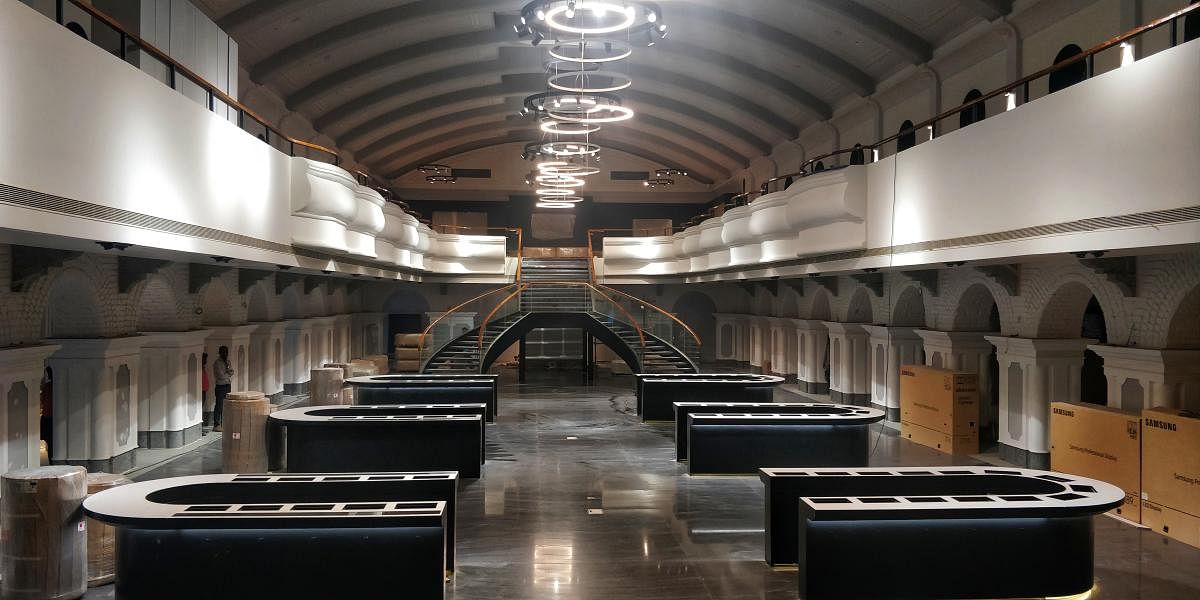
Meticulous work went into the restoration of the New Opera cinema, a grand heritage structure at the intersection of Residency Road and Brigade Road.
The British-era building that once hosted live music and screened movies is now called the Samsung Opera House, and undergone various levels of restructuring to appear the way it does today. No part was demolished.
After building owner K Ramakrishnan began the restoration, Brawn Globus, an interior Fit-Out company, stepped in to do up the interiors.
The inside walls now have a false padding. The original stone, brick and mortar walls remain.
The floor, muddy and broken in many parts, was excavated manually and redone. Likewise, the ceiling, restored by the owner, got a fresh coat of paint once the interior Fit-Out stepped in.
Talking about how Brawn Globus bagged the deal, Pavan Veeraghanta, project manager of the entire interior Fit-Out work, says, “We came into the picture in January and the building was pretty much just a skeletal structure. Ramakrishnan, the owner, was already working on restoring it. Samsung had given us the interior and exterior landscaping and the brief was to bring it up to new age construction standards.”
The main challenge was to work without disturbing the original structure.“The structure was originally built with lime mortar and stone which you don’t see nowadays. These structures are difficult to deal with because you don’t know how much load they can take, how they react to being worked on, and how much resistance they have to damage,” says Veeraghanta.
A padding had to be added to ensure the original walls were protected. “We have restored them using PoP and repainted them to make them appear smooth,” he adds.
Some parts of the floor were made of concrete, apparently a modification of the floor laid in mud/concrete, when the building was first constructed.
“We completely excavated the floor and got it done manually. About 100 labourers worked on the floor alone. It was a very labour-intensive job. The floor was levelled using concrete and we ensured that the cabling work was done before that. The spiral stairway that adorns the central space was built from scratch by us,” Veeraghanta explains.
The flooring now uses engineered marble, whose maintenance is easy, he says.
Additional layers
The original wooden flooring on the first floor has been retained and an additional wooden floor placed over it. “A supporting foam layer on the original floor acts as a double protective layer. It protects the wood from being eaten by insects. It is easy to take off and retains the original look,” he says.
Stage
The wooden floor on the central stage was redesigned. “A small wooden seating has been added on. This is done to give the space an easy and laidback feel. The seating on the stage can be dismantled like any furniture,” says Pavan.
Culture, not cars
The designers were keen to use the frontal space in a productive way. “The idea of landscaping it and redoing it to offer an amphitheatre set-up is to allow people to walk in, instead of using the space for car parking. There are five levels that can accommodate about 200 people at a time,” explains Veeraghanta of Brawn Globus designers. The space is ideal for bands and artistes to perform. Anti-skid tiles allow for easy movement and prevent slipping," adds Veeraghanta.
Opera House
The land was bought by contractor T C W Skipp in 1913. He later built a theatre there, so we can date the building to the late 1910s. During that time Opera House was mainly used as a venue for dances and theatrical performances. A few years after Skipp’s death, in 1939, his heirs sold the property to Indian owners, who planned to run it as a cinema, and that is possibly when the bright neon sign of ‘New Opera’ went up to highlight its earliest repurposing. It later became a hotchpotch arena where B-Grade movies vied were screened, and it was used as a convenient hangout at the end of Brigade Road.